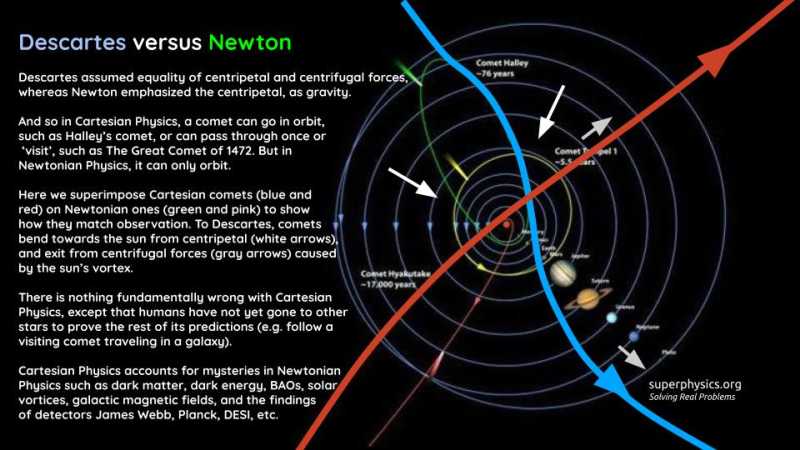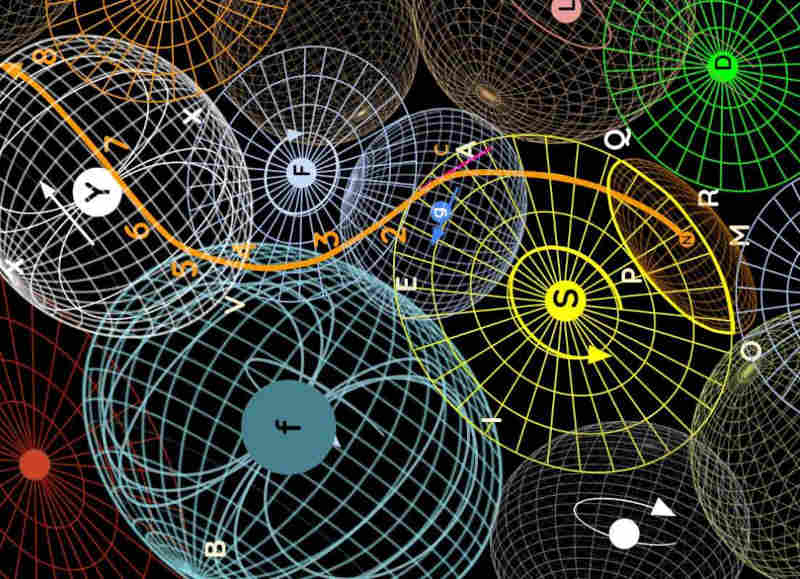Comets and Climate Change
Table of Contents
Comets are small objects that traverse a stellar system with or without an orbit, producing a ’tail’ from ‘outgassing’.
These are opposed to:
- asteroids which are objects that orbit between Mars and Jupiter
- meteors which are objects that break off from those comets and asteroids
Both Cartesian and Newtonian Physics base the eccentricity of a comet’s orbit on the comet’s momentum – there is no disagreement in that regard. We superimpose the 2 beliefs on the orbits of known comets Halley and Hayakutake below.

Somehow, Newton attacks the Cartesian system by imagining that a Spacetime Vortex (represented by our solar system) will force a comet into a circular orbit instead of an elliptical one.
The motions of the comets are exceedingly regular, are governed by the same laws with the motions of the planets, and can by no means be accounted for by the hypothesis of vortices.
Comets are carried with very eccentric motions through all parts of the heavens indifferently, with a freedom that is incompatible with the notion of a vortex.
Newton
Principia Mathematica, General Scholium
But that will be the logic of someone who does not know that the comet’s entry momentum into Solar System 1 is dictated by the Solar System 2 where it exited.
How a Comet Traverses Solar Systems
When comet 2 (along orange line below) enters Stellar System F, its momentum comes from the qosts that push it from Solar System S that it just exited.

This literally adds matter, as mass, to Stellar System F and reduces them in Solar System S. This creates gravitational changes in both systems because there is no void either.
- The comet will either pass through
Solar System 1if the momentum from its speed is strong enough to resist the speed of the qosts fromStellar System F. - The comet will fall into an eccentric orbit if its speed is not faster than those of
Stellar System F. This is similar to failing the escape velocity in a planet.
Climate Change
The entry of a comet increases:
- the mass within a solar system in proportion to the comet’s size
- the gravitational displacement, from the displaced qost, in proportion to the comet’s speed.
- A fast bowling ball can topple more pins than a very slow one
Atmospheric events are primarily affected by gravitational effects of the spatial layer and only secondarily affected by the heat and magnetism of the radiant layer.
In fact, it is gravity from mosts that keeps our atmosphere where it is.
- The atmosphere of Mars was taken away by planetary bodies, such as large asteroids or planetoids, that passed near it.
A comet coming near a planet will alter its atmospheric conditions.
This then might lead to changes in weather or climate while that comet is within the solar system. This is why comets are associated with climate change more than asteroids or meteorites since the latter are not “foreigners” to the solar system.
This is possibly how the Great Comet of 1472 could have contributed to the cold spell from 1430s and how those of 1556 and 1577 caused that of the 1560s.
Newton and Einstein did not know the mechanics of space particles and so could not connect comets to climate change.